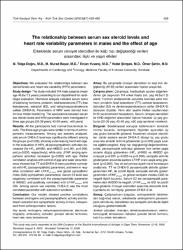| dc.contributor.author | Doğru M.T. | |
| dc.contributor.author | Başar M.M. | |
| dc.contributor.author | Yuvanç E. | |
| dc.contributor.author | Şimşek V. | |
| dc.contributor.author | Şahin Ö. | |
| dc.date.accessioned | 2020-06-25T15:14:30Z | |
| dc.date.available | 2020-06-25T15:14:30Z | |
| dc.date.issued | 2010 | |
| dc.identifier.citation | Doğru, M. T., Başar, M. M., Yuvanç, E., Şimşek, E., Şahin, Ö. (2010). The relationship between serum sex steroid levels and heart rate variability parameters in males and the effect of age. Türk Kardiyoloji Derneği Arşivi, 38(7), 459 - 465. | en_US |
| dc.identifier.issn | 10165169 | |
| dc.identifier.uri | https://hdl.handle.net/20.500.12587/2127 | |
| dc.description | PubMed: 21206198 | en_US |
| dc.description.abstract | Objectives: We evaluated the relationships between sex steroid levels and heart rate variability (HRV) parameters. Study design: The study included 114 male subjects (mean age 46.6±11.3 years) presenting to our department for cardiologic evaluation. Hormonal analysis included serum levels of luteinizing hormone, prolactin, total testosterone (TT), free testosterone, estradiol (E2), and dehydroepiandrosterone sulfate (DHEA-S). Parameters of HRV were derived from 24-hour Holter monitoring. The associations between serum sex steroid levels and HRV parameters were investigated in three age groups (20-39 years; 40-59 years; >60 years). Results: All the participants had normal biochemical results. The three age groups were similar in terms of anthropometric measurements. Among sex steroids analyzed, only serum DHEA-S level was significantly different among the groups (p=0.026), showing a decreasing trend with age. In the evaluation of HRV, all parasympathetic activities decreased (for HFn, pNN50, and rMSDD: p=0.001, p=0.000, and p=0.000, respectively), while only LF/HF among sympathetic activities increased (p=0.000) with age. Partial correlation analysis with control of age and waist circumference showed that TT and DHEA-S were positively correlated with HF n (parasympathetic parameter), and were in negative correlation with LF/HF24 hours and global sympathetic index (GSI) (sympathetic parameters). Serum E2 level was negatively correlated with the parasympathetic parameter of rMSSD, and positively correlated with LF/HF24 hours and GSI. Among serum sex steroids, DHEA-S was the most correlated parameter with autonomic functions. Conclusion: Our results showed positive correlations between androgens and parasympathetic activity and between estradiol and sympathetic activity in men, independent from anthropometric factors. | en_US |
| dc.language.iso | eng | en_US |
| dc.rights | info:eu-repo/semantics/closedAccess | en_US |
| dc.subject | Androgens | en_US |
| dc.subject | Dehydroepiandrosterone | en_US |
| dc.subject | Electrocardiography, ambulatory | en_US |
| dc.subject | Estradiol | en_US |
| dc.subject | Gonadal steroid hormones | en_US |
| dc.subject | Heart rate | en_US |
| dc.subject | Male | en_US |
| dc.subject | Testosterone | en_US |
| dc.title | The relationship between serum sex steroid levels and heart rate variability parameters in males and the effect of age | en_US |
| dc.type | article | en_US |
| dc.contributor.department | Kırıkkale Üniversitesi | en_US |
| dc.identifier.volume | 38 | en_US |
| dc.identifier.issue | 7 | en_US |
| dc.identifier.startpage | 459 | en_US |
| dc.identifier.endpage | 465 | en_US |
| dc.relation.journal | Turk Kardiyoloji Dernegi Arsivi | en_US |
| dc.relation.publicationcategory | Makale - Ulusal Hakemli Dergi - Kurum Öğretim Elemanı | en_US |
















